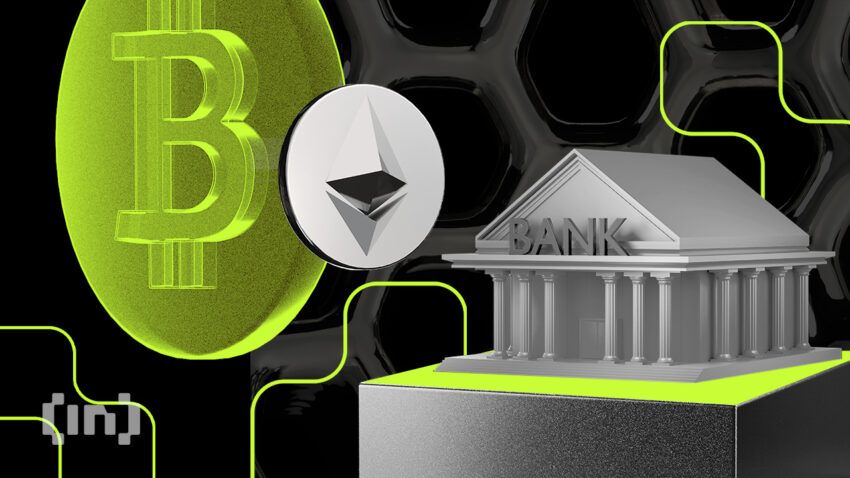In Switzerland, known for its role in global finance, the first-ever Web3 Banking Symposium shone a spotlight on the future of money. Organized by the Crypto Valley Association, this event gathered minds from across the financial spectrum.
BeInCrypto talked with Ilya Volkov, Crypto Valley Association Board Member and CEO of YouHodler, who is at the forefront of blending traditional banking with digital assets. He shared his insights on how banking is evolving with Web3, discussing the current state, future possibilities, and what this means for customers and institutions.
Ilya Volkov is the CEO and co-founder of YouHodler, a Swiss-based Web3 platform providing innovative fintech solutions that bridge fiat and crypto financial services. With almost 20 years in the fintech industry, his expertise covers commercial finance, online trading, and Web3 financial services. Ilya is a Board member of Switzerland’s Crypto Valley Association and serves as an ambassador for Innovaud, an agency promoting innovation and investment in the canton of Vaud, Switzerland.
Not Your Average Crypto Event
Web3 Banking Symposium, held in Geneva in early March, was the first event fully dedicated to the banking industry and the integration of digital assets by traditional financial institutions. Organized by the Crypto Valley Association, it attracted over 300 participants and covered five key topic areas: legal aspects, AML and compliance, tax and accounting, infrastructure, and product development, showcasing examples of crypto-friendly banks and blockchain businesses compliant with traditional banking regulations.
«The event was truly unique as the banking industry, traditionally a very closed one, opened up to discuss innovations, symbolizing a significant turning point, especially after a series of collapses in the US in previous years, highlighting banks’ increased interest in the cryptocurrencies. It’s very difficult to shake up bankers so that they come and openly discuss some innovative topics. In this case, CVA managed to do it, bringing value to all industry».
The symposium also highlighted Switzerland as a global blockchain hub, bringing together representatives from banks, entrepreneurs, and politicians from all linguistic regions of the country, emphasizing the country’s commitment to supporting the sector on a regional level.
«The first cryptocurrency banks appeared in Switzerland in 2019, causing a lot of skepticism among traditional players. However, over time, they felt the FOMO, realizing the possibility of missing out on a promising trend. This led to the fast development of the market, where traditional financial institutions started to actively integrate cryptocurrency services, responding to the demands of their customers. Even the most conservative bankers now understand that banks risk becoming irrelevant without catering to the younger generation and retaining existing clients».
Evolution, Not Revolution
Speaking of the current state of the scene, Volkov notes that cryptocurrencies are not a revolution but rather an evolution in the financial sphere. He defines Web3 bank as a financial institution that combines centralized and decentralized services, investment products from traditional and cryptocurrency areas, and a 360-degree view of payment and merchant services, including blockchain technologies for payment processing. This approach demonstrates the integration of innovation into the financial industry, similar to the evolution of mobile phones and contactless payments, which have quickly gone from novelty to necessity.
«Absolutely every innovation that humanity has invented goes through this process. 30-40 years ago, it was impossible to imagine having mobile phones. Thanks to companies like Nokia, it became possible, and now it’s required. The same things are happening in the payment industry. Apple Pay and Google Pay went through this cycle quickly; now, contactless payments are necessary. If we are talking about retail banks, they are required to have such things tied to their cards. And what is happening is that crypto is now at the expected level. Traditional bank customers are asking how to buy Bitcoin, whether you can buy a tokenized asset, how to store it, and so on. This suggests that it will be absolutely required soon».
Examples of traditional financial institutions, such as PostFinance working with Signum or Amina (formerly Seba Bank), which provides infrastructure for the St.Galler Kantonalbank, as well as initiatives by large banks and companies, including Societe Generale (Forge), Citibank, and Visa, confirm this trend. They offer services related to digital assets and develop them in partnership with cryptocurrency-oriented companies.
Trending Now in Web3 Banking
As our conversation unfolds, the CEO names two key trends that stand out in the current landscape of Web3 banking. The first relates to the active buying and selling of established cryptocurrencies like Bitcoin and derivatives. According to Volkov, this is the most obvious trend actively explored by clients of even the most conservative banks.
The second trend is the tokenization of real assets, from securities to art, such as Picasso’s works, giving them a new level of transparency and efficiency via blockchain. These tendencies evolve the idea of trading and holding assets and show the traditional and innovative banks’ adaptation to new market demands.
«Many banks focus on tokenization of classic securities and other assets. Several projects are working with gold, diamonds, and real estate. Signum Bank did a very interesting project a couple of years ago: they tokenized several Picasso works here in Geneva. We have all seen this buzz with NFTs. Sure, it adds some hype to the market, but apart from all that, there are real deals where we talk about real art».
Volkov also points to the development of lending and staking as examples of successful integration of crypto-instruments into financial services, marking the importance of promoting these services to audiences. He underlines that staking is already attracting attention, thanks to regulatory clarifications in Switzerland, and has the potential to compete with traditional financial instruments. However, it currently needs to catch up with the economic situation.
«What is staking for the average bank client? It’s the placement of capital at interest. Currently, Ethereum pays you 4,5% per annum while US Treasury Bonds pay 5%, so choosing between them, many clients naturally go to bonds. Here, we have normal, healthy competition between different instruments. One day, the economic environment will change, money will become cheaper, DeFi will pay more interest than TradFi, and there will be a spillover. But technically, everything is ready — the regulatory framework, at least in Switzerland, is clear here».
Critical Steps to Success
Discussing the processes of launching a cryptocurrency business in banking, YouHodler CEO highlights five key elements:
- Regulatory compliance and accounting. It’s important to consider the nuances of regulatory requirements and accounting specific to crypto transactions
- KYC/AML compliance. Despite appearing similar to traditional requirements, the cryptocurrency sector has unique customer due diligence and money laundering requirements
- Blockchain infrastructure. Having secure storage, wallet systems, managing different blockchains, and the ability to work with smart contracts
- Liquidity. Integration with liquidity providers in cryptocurrency and traditional financial sectors
- Cybersecurity. Blockchain infrastructure can be exposed to attackers and bad actors 24/7, 365 days a year
Volkov highlights that there is no need to ”reinvent the wheel”, for all essential elements listed above a partnership ecosystem already exists: legal advisors, technology providers, fintech companies, and specialized banks who are ready to provide newcomers with all the pieces of technology.
Based on this list, the CEO identifies four important areas for developers who want to cooperate with traditional banking. First, he emphasizes the importance of custodial services, citing the example of Metaco, which developed a unique solution and was acquired by Ripple. This shows room for new entrants, even in a competitive environment. The second aspect is providing liquidity, where it is important to integrate with various players, including exchanges and OTC desks, with Talos as a successful example.
Volkov also points out the need to develop KYC and AML compliance solutions. Despite the seemingly saturated market, there’s still a space for innovation, given the ever-changing regulatory field. The Travel Rule and Transfer of Fund Regulation need a very non-trivial automation, so talented developers are very welcome to keep up with the entire regulatory environment. Another trend requiring attention is the development of white-label solutions for banks that want to test new technologies without building everything from scratch.
The Inevitable Convergence
In his closing thoughts, YouHodler CEO touches on the “sore subject” of the transition from centralized to decentralized asset storage and management, noting that this will become a reality in the near future. This change will require banks to be flexible in combining these approaches to meet customer demands for decentralization.
«Money should be decentralized. But at the same time, any customer, whether institutional or retail, should have access to request it from a bank or a financial institution. Then, the standard mechanics will be used, as in traditional finance. The topic of non-custodial wallets for conventional financial institutions is very painful now. But in a few years, this trend will become a reality».
The merger of traditional banking and the crypto industry is imminent. The banks working with cryptocurrencies are already showing their balance sheets and are under the supervision of regulators, which indicates that such a model is functioning. At the same time, challenges exist on both sides, both in adapting exchanges to regulation and in the application of the latest technology by banks moving towards digital assets.
Trusted
Disclaimer
In compliance with the Trust Project guidelines, this opinion article presents the author’s perspective and may not necessarily reflect the views of BeInCrypto. BeInCrypto remains committed to transparent reporting and upholding the highest standards of journalism. Readers are advised to verify information independently and consult with a professional before making decisions based on this content. Please note that our Terms and Conditions, Privacy Policy, and Disclaimers have been updated.


